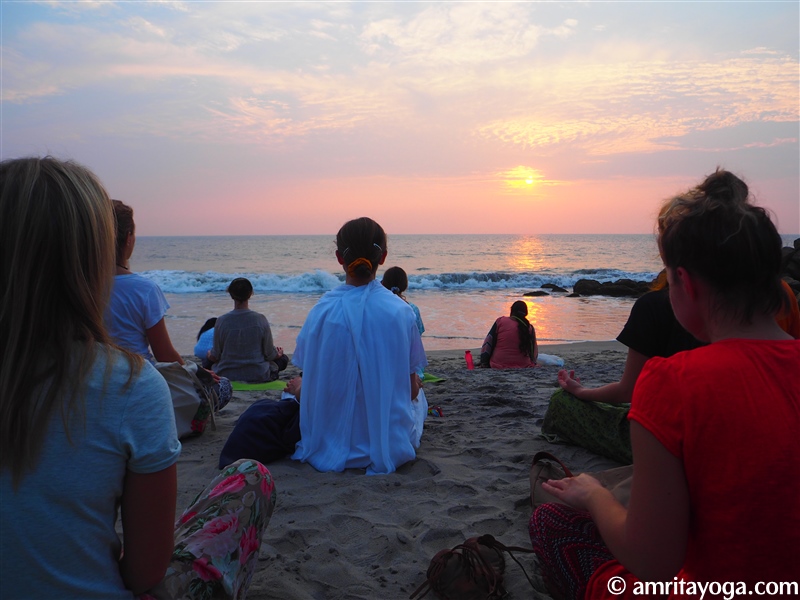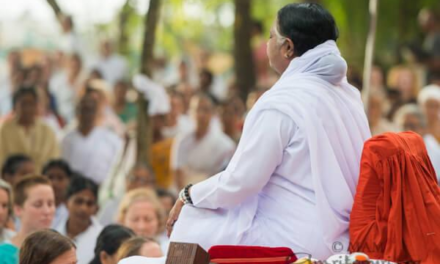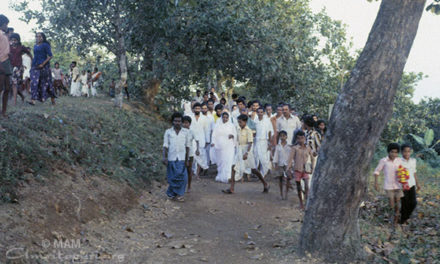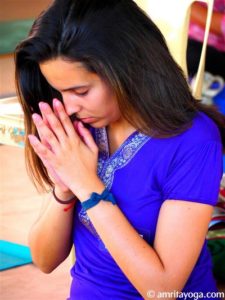
Prayer Asana at Amrita Yoga workshop.
The Shiva Shakti Sadhana Workshop was a wonderful way to start the new year by finding a deep inner balance. This Workshop is designed to be a restorative journey into our essence. Many students found inner healing and acceptance of their physical (and emotional) imbalances.
One devotee in particular, Chidambaran, shared his experience of surrender. He had hurt his shoulder but was able to fully experience the workshop in a state of surrender with an open heart and a great sense of humor!
Chidambaran reflected, “I realized that my shoulder injury showed me how powerless I was in this situation. The injury affected my left side which is the feminine receiving side. I realized I was out of balance regarding my feminine aspects. The injury also showed me how my intentions were not necessarily in harmony with Amma’s plans. And when I surrender, I find there is always a safer way to connect with others.”
This is a great metaphor for our spiritual path. Sometimes life tosses us up in the air when we least expect it. We can chose to be angry and blame life, or we can take it as a lesson in discrimination. As devotees, we learn to accept everything from life as Prasad (a blessed gift) from Amma.
As Amma says: “When we are not able to swim against the current, we just keep swimming to learn.”
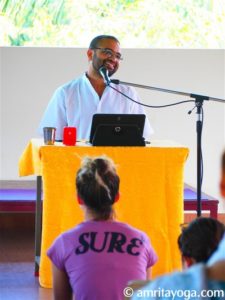
Satsanga (spiritual talk) at Amrita Yoga workshop.
Asana practice can train us towards such acceptance. Many students who attended the restorative workshop had ongoing injuries that they were hoping to treat. Others, who had hoped for a more advanced class, realized that what they really needed was this healing practice. They found that self-love and the acceptance of their pain and injuries was more important that trying to push themselves to get better. The workshop also had satsanga by ashram Brahmacharis and Brahmacharinis.
Here is what one attendee had to say:
“The Shiva Shakti Yoga Sadhana Workshop was very inspirational for me – but not exactly in the way I was originally expecting. I signed up for the workshop to help heal some chronic pain I have had in my back for some time. After five days, yes, the pain is still there, but not only do I have a new set of tools/asanas to practice that are more gentle – I have more love and compassion for myself and an inner strength I haven’t felt before. This is where the true gold lies in this sadhana workshop. Brahmacharini Shobhana’s method of teaching, and HER VOICE! (the chanting and significant emphasis placed on inner contemplation) were incredibly healing for me. I also have more faith and strength to accept and move forward with my physical pain. Great class, so grateful!” – Shantimayi, 32, USA
The Shiva Shakti Principle
Samkhya philosophy is the ancient source for the concepts of Shiva and Shakti and is a systematic way of explaining the many levels of reality present in existence. Samkhya means number. The philosophy divides creation into twenty three categories from gross to subtle. An ancient wisdom from time immemorial, Samkhya dawned in the mind of Sage Kapila. In this wisdom, Shiva is known as Purusha or consciousness and Shakti is Prakriti or matter.
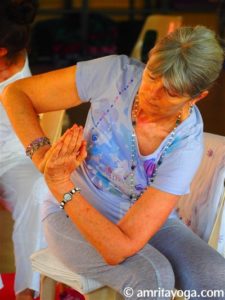
Gentle twist Asana at Amrita Yoga workshop.
Shiva is potential energy while Shakti is kinetic energy. Just as in physics, any object that is seemingly inert has potential energy. This potential energy is converted into kinetic energy when the object is moved.
Human beings are both the infinite potential and its expression. We are made of different layers of matter, from the gross matter that makes up our body to the subtle matter that is our mind. We are obviously identified with our body and mind, but if we could apply jnana or wisdom (spiritual knowledge), we could separate purusha from prakriti – consciousness from matter – and be liberated of our ignorance. This ultimate attainment is called by many names: moksha, nirvana, self-realization, etc.
In Samkhya philosophy, only an individual soul, or jiva, can achieve liberation. Unfortunately, it does not give any method or knowledge on how to attain moksha. The methods are given by other Indian philosophies, like Advaita Vedanta. In Advaita, the two principles of Shiva and Shakti are not separate but one; in other words, as Amma often says: “The Creator and Creation are not different, but the same.”
Manifestation is Shakti – names and forms are superimposed on the underlying substratum of consciousness or Shiva. For example, we are aware that we exist but we are also aware that we are always changing. Our bodies undergo many changes as we grow, and our minds constantly fluctuate. If we think of the vastness of the ocean, it is made up of many waves. If we focus on each individual wave, we call this Shakti, but if we focus on the underlying form of water, we call it Shiva.
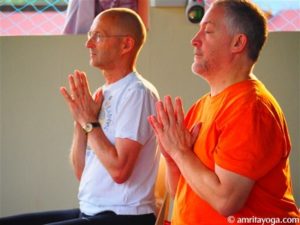
Devotion practice at Amrita Yoga workshop.
The Shiva Shakti Principle is a powerful tool in the practice of yoga. We can start to explore our own thoughts and bodies to find what is constant and what is changing. During the Shiva Shakti Sadhana Workshop, our teacher used Sanskrit mantras and slokas to help us attune to sounds and their subtle vibrations. These sacred syllables have a sound that can deeply penetrate the different layers of our bodies and minds. Many students commented on the deep healing effect of these beautiful Vedic chants. They felt like Amma was rocking them in a little boat and singing lullabies to them! The metaphor of being on an ocean is very apt, as one of the Goddess’s many names is Bhavatarini – the one who helps us swim across this material world.
We can also meditate on the Shiva Shakti principle in the Kali Temple at Amritapuri. There in the sanctum is a beautiful representation of this principle. Goddess Kali is dancing on Lord Shiva’s chest. His expression is one of great bliss while Her’s is pure love. She promises to free us from our ego as one of her hands form the Abhaya mudra (mudra of protection) and another hand is in Varada mudra (mudra of bestowing boons). This is how Shakti dances on Shiva – life dances on the substratum of consciousness. We can also learn to dance in life all the while remaining a witness, remaining grounded in consciousness or awareness.
This Yoga Sadhana Workshop introduced us to these mudras amongst others. Students remarked how the workshop was like no other they have taken. They truly appreciated learning these esoteric tools to help them in their asana practice.
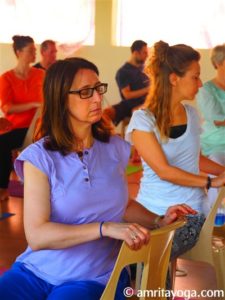
Seated twist Asana at Amrita Yoga workshop.
Yoga Nidra
On the final day of the Workshop, students had a relaxing Yoga Nidra session. This is another great yogic tool to help us remain conscious in a relaxed state. The teacher’s voice helped guide us deeply into ourselves to the point where many students were completely unaware of the noise outside! Many meditators spend a lot of energy trying to find ideal conditions in which to practice – like a nice quiet studio with the right temperature and all the amenities.
At Amritapuri, even the non-ideal conditions can be the right conditions! Amma, the Satguru guides us to the conditions we need for growth. Every situation in Amritapuri can be conducive to our yoga practice. It depends on our ability to tune to Amma’s guidance and our receptivity. We can remain blissfully aware while life dances with us like Lord Chidambaram, one of the names of Lord Shiva. Even if an elephant tosses us playfully, we will roll with it and laugh and move forward in all our spiritual practices!
Author: Rosario Kerekes

